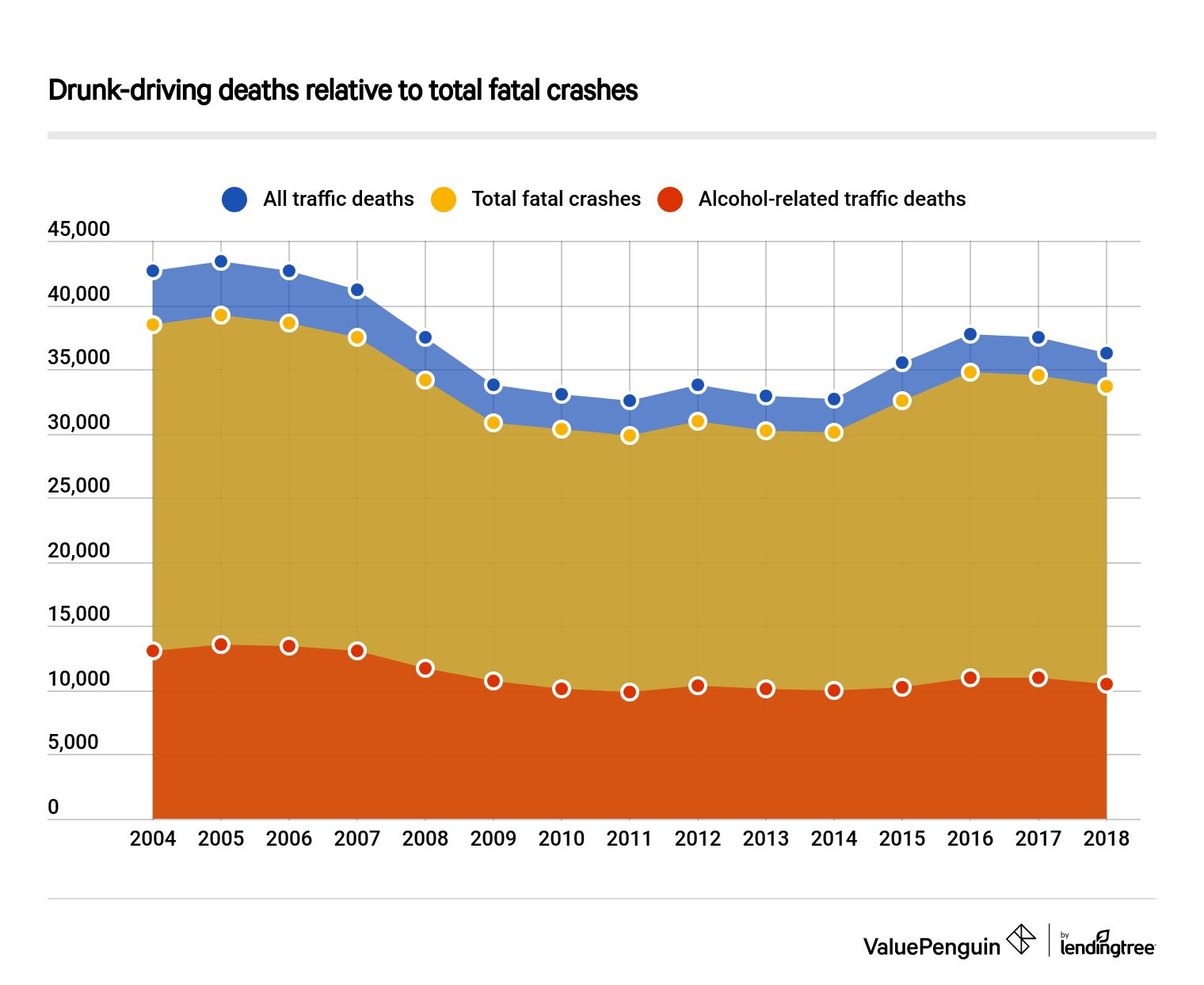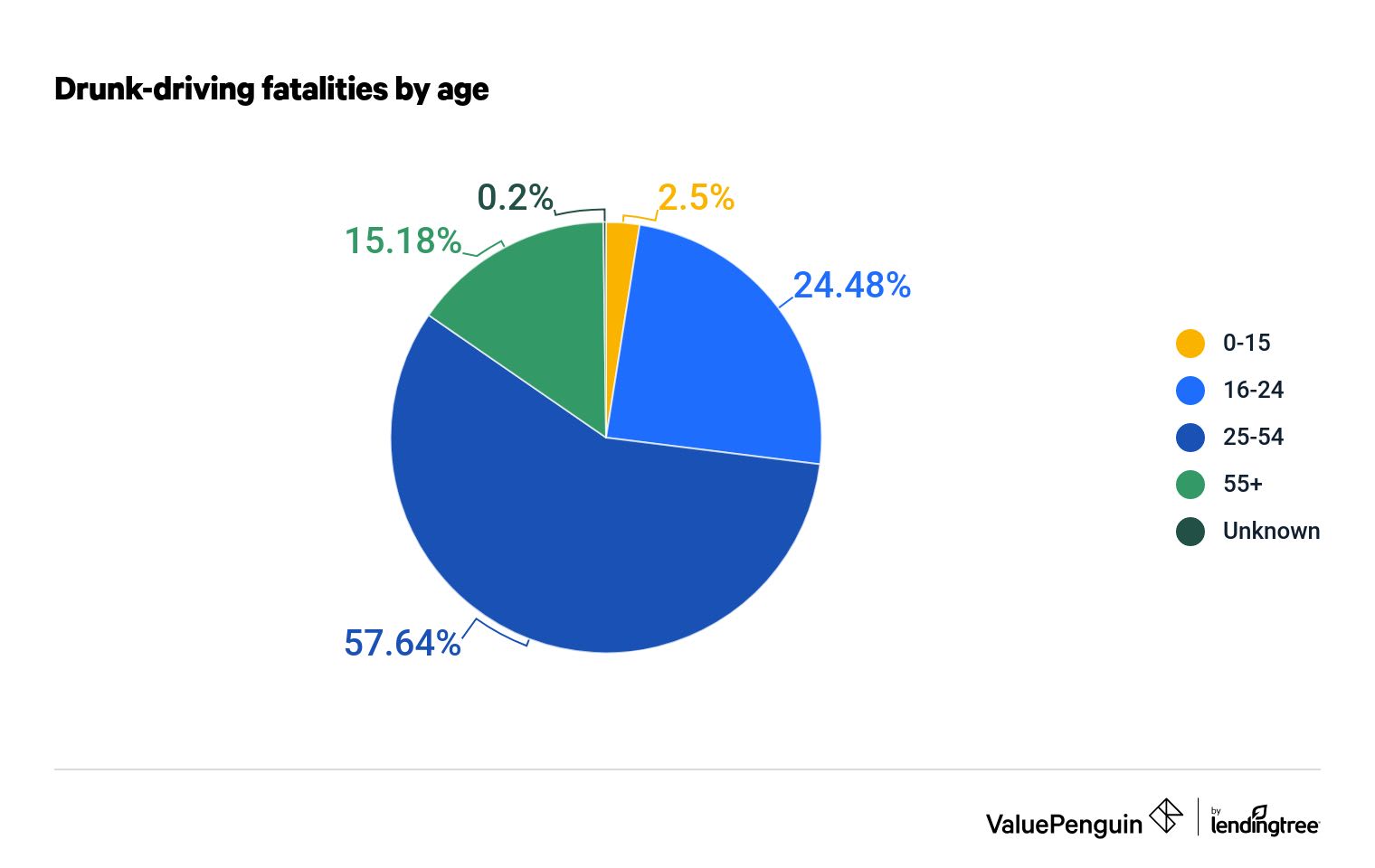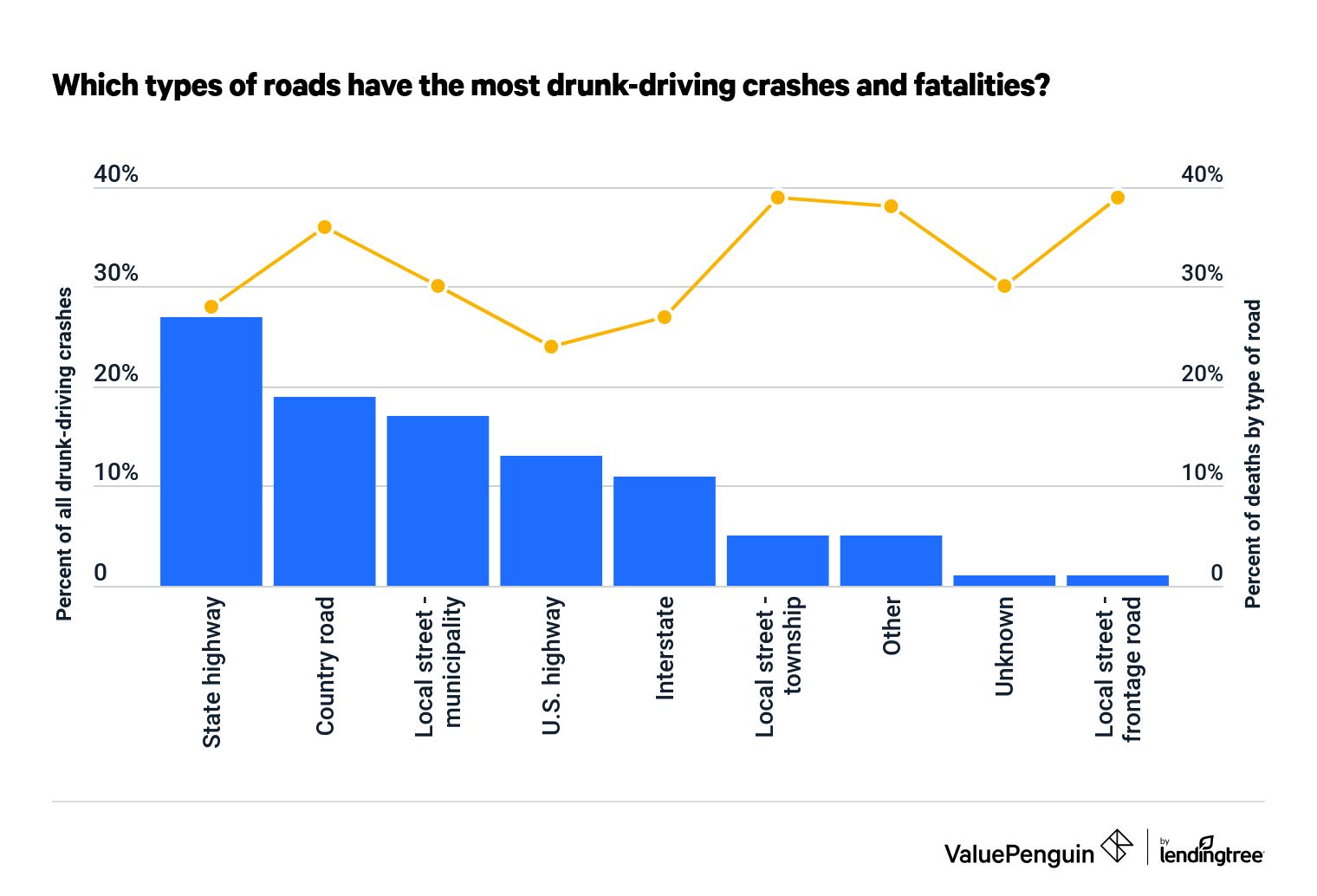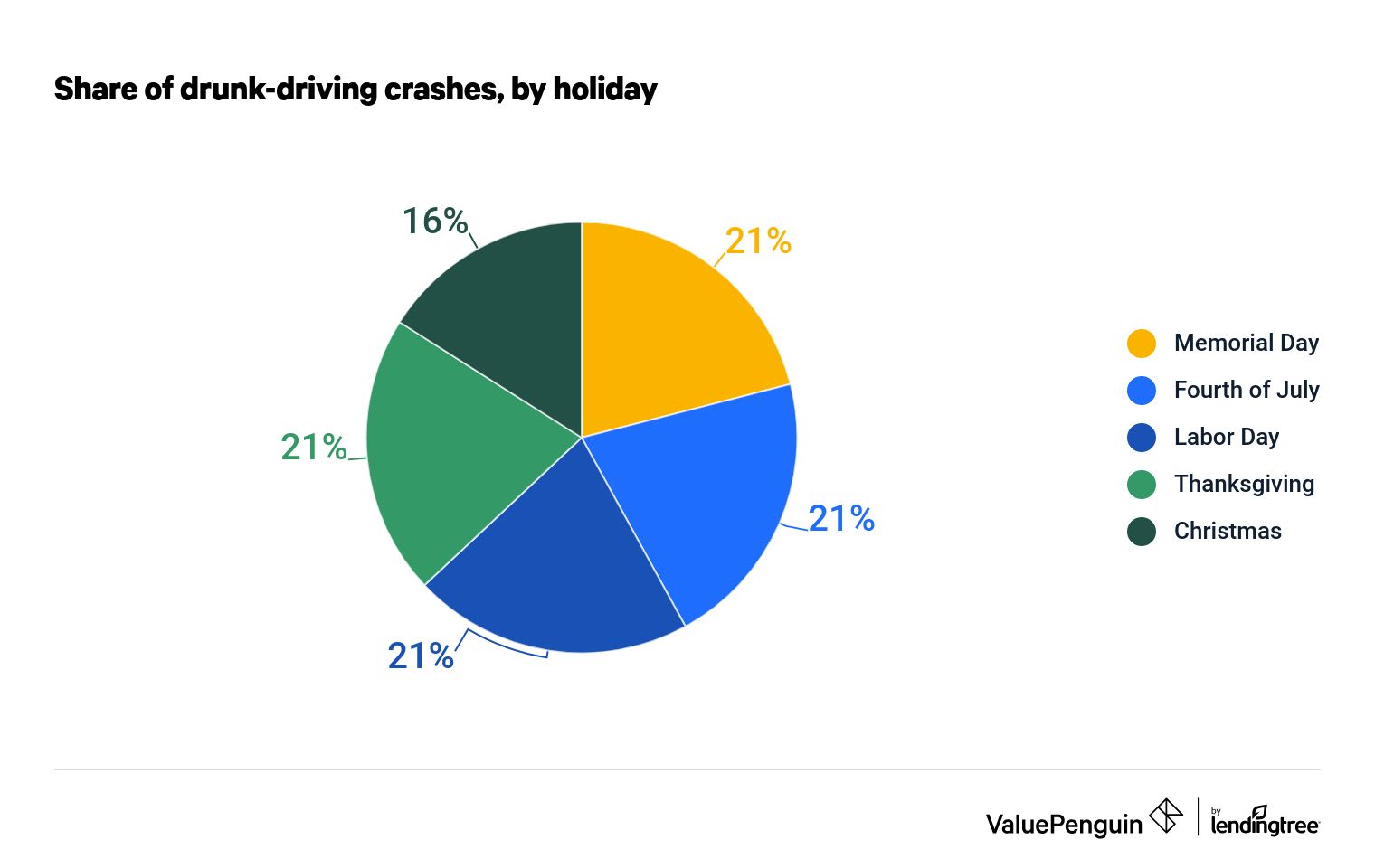Drunk Driving Statistics
ValuePenguin analyzed data from the National Highway Traffic Safety Administration (NHTSA) and estimated that drunk driving is responsible for about 1 in 3 traffic fatalities. While this is the ratio for the United States, the frequency of alcohol-impaired driving accidents can vary depending on the driver's age, their location and the time of year.
The breakdowns on this page evaluate crashes where a driver's blood alcohol concentration (BAC) was equal to or greater than 0.08 grams per deciliter, resulting in alcohol-impaired driving. This is in alignment with the NHTSA's guidelines and the legal limit in nearly every state.
How many people die from drunk driving?
The National Highway Traffic Safety Administration (NHTSA) reports that the annual number of fatal traffic accidents dropped by 14% between 2004 and 2018. In the same period, the number of fatalities fell from about 43,000 to 36,000 per year. Of these, over 30% were the product of drunk driving.
Even though the share of traffic fatalities attributable to drunk driving was consistent, from 2004 to 2018, the number of people killed by drunk driving dropped by about 18%. From 2004 to 2011, each year saw fewer drunk driving deaths than the year before. While deaths from drunk driving were about 7% higher in 2018 than they were in 2011, deaths were still down overall.

Is drunk driving a felony?
Receiving one conviction for drunk driving is ordinarily a misdemeanor, not a felony. The penalty for a misdemeanor doesn't involve jail time but could include a fine or community service — along with substantial hikes to your car insurance premiums. However, a driver arrested for drunk driving could face felony charges if they injure or kill another person. Additionally, being pulled over with a minor in the car while driving drunk without a license or with a suspended license, among other situations depending on the state, could result in a felony charge for drunk driving.
Drunk driving deaths by state
On average, 30% of roadway fatalities were caused by alcohol-impaired drivers from 2004 to 2018. In 20 states, the percentage was higher. Relative to all traffic deaths, North Dakota had the largest percentage of fatalities resulting from drunk driving of any state. In North Dakota, 40% of traffic deaths were owed to alcohol-impaired drivers.
At the same time, there were relatively few total traffic fatalities in North Dakota from 2004 to 2018. As a result, the number of deaths from alcohol-impaired driving was the sixth-lowest of all states. Instead, Texas had the most total traffic deaths from drunk driving: more than 20,000 drunk driving fatalities. In Texas, drunk driving was responsible for 39% of all traffic deaths from 2004 to 2018.
Washington, D.C., had the lowest number of people killed by drunk drivers during this time period. In the nation's capital, alcohol-impaired driving caused 33% of all traffic deaths, though only 423 people were killed in total. In Utah, drunk driving was responsible for only 19% of the traffic deaths in the state. Utah was the only state where the ratio fell below 20%.
State | Deaths from alcohol-impaired driving | Percentage of statewide traffic deaths |
|---|---|---|
| United States | 168,744 | 30% |
| North Dakota | 752 | 40% |
| Montana | 1,290 | 39% |
| Texas | 20,292 | 39% |
| Rhode Island | 392 | 38% |
| Connecticut | 1,611 | 38% |
| South Carolina | 5,387 | 38% |
| Hawaii | 646 | 37% |
| Wisconsin | 3,372 | 36% |
| Massachusetts | 1,979 | 35% |
| Delaware | 608 | 34% |
| Washington | 2,642 | 34% |
States are ordered from highest to lowest by percentage of total traffic deaths that resulted from drunk driving.
Drunk driving deaths by age group
Alcohol-impaired driving causes many fatal traffic accidents involving adolescents and young adults. From 2004 to 2018, 115,000 people aged 16 to 24 years old died in traffic accidents. Deaths in this demographic amounted to about one-quarter of the total traffic deaths involving alcohol across all ages during this time period. However, alcohol-impaired driving was responsible for 36% of traffic deaths affecting 16- to 24-year-olds.
This was second only to a much larger demographic, 25- to 54-year-olds. Thirty-eight percent of the traffic deaths affecting this age group were the result of drunk driving, resulting in more than 97,000 fatalities — nearly 58% of all drunk driving deaths.
Conversely, there were fewer alcohol-related deaths among the oldest and youngest people on the roads. Those 15 years old and younger made up 2.5% of the total fatalities from drunk driving. A total of 4,198 of these people were killed by drunk drivers — the fewest of any defined age group. Alcohol-impaired driving was responsible for about 26,000 deaths among people aged 55 or older. This number was about 15% of the nationwide total.

Most dangerous types of roads for drunk driving
State highways are the roads where drivers are most likely to be involved in fatal crashes that are caused by alcohol-impaired driving. Since 2010, when the NHTSA started tracking incidents by road type, the number of fatal alcohol-related crashes on state highways has made up 27% of the country's total alcohol-related fatal accidents. On state highways, more than 25,000 people were killed in alcohol-related crashes. This means that alcohol was a factor in 28% of the fatalities that occurred on state highways during this time period.
Local roadways saw nearly 24% of the total fatal crashes that occurred nationwide as a result of alcohol-impaired driving.
County roads were responsible for a large share of roadway fatalities. There were more than 16,000 fatal crashes involving alcohol on these roads, making up 19% of the national total. More than 17,000 people have been killed by alcohol-impaired drivers on county roads since 2010. This means that alcohol-impaired drivers were responsible for about 36% of the total traffic deaths that occurred on county roads.

Which holidays have the most drunk-driving accidents?
From 2005 to 2018, there were more fatal crashes that resulted from drunk driving on the Fourth of July and Thanksgiving than any other holidays. Forty-two percent of the alcohol-related fatal crashes that occurred on or around holidays happened on these two. In total, there were more than 4,200 alcohol-related fatal crashes between 2005 and 2018 on the Fourth of July and Thanksgiving.
Generally, there isn't much variation in the number of fatal car accidents that occur on or around a given holiday. Labor Day, Memorial Day, the Fourth of July, Thanksgiving and Christmas all accounted for about 20% of the total number of traffic deaths from drunk driving, on average. Christmas, during which about 16% of fatal traffic accidents involving alcohol happened, was the smallest contributor to the total figure of more than 10,000 fatal drunk-driving accidents on holidays.

How drunk driving affects car insurance
ValuePenguin calculated that the cost of a full coverage car insurance policy in the nation's 10 largest states can increase by an average of $3,555 after a DUI conviction. Typically, this was an increase of 123% from the standard cost of car insurance.
The largest price surge happened in North Carolina, where a sample driver experienced an increase of nearly 300%, from $1,576 to $6,238. Rates in California and Michigan also rose by more than 100% after a drunk-driving conviction, with the price increasing in Michigan by more than 200%.
In only two states did the average cost of insurance rise by less than 50%. In Ohio and Illinois, the cost of car insurance increased by 44% and 49%, respectively. In fact, even after a DUI conviction, drivers could still pay cheaper prices for car insurance than average, compared to the other eight states.
State | Before DUI | After DUI | Percentage change |
|---|---|---|---|
| Average | $2,879 | $6,434 | 123% |
| California | $1,808 | $5,112 | 183% |
| Texas | $2,340 | $3,704 | 58% |
| Florida | $3,905 | $6,208 | 59% |
| New York | $2,502 | $3,801 | 52% |
| Pennsylvania | $2,011 | $3,192 | 59% |
| Illinois | $2,236 | $3,326 | 49% |
| Ohio | $1,576 | $2,267 | 44% |
| Georgia | $2,386 | $3,924 | 64% |
| North Carolina | $1,567 | $6,238 | 298% |
| Michigan | $8,464 | $26,571 | 214% |
States are arranged by their population, from most- to least-populated.
Drivers who are convicted of driving while intoxicated may be deemed high risk and have to purchase SR-22 insurance. An SR-22 isn't a form of coverage. Rather, it's a certificate obtained and filed by the driver's insurance provider that shows financial responsibility. Drivers whose licenses have been suspended after a DUI, or other high-risk behavior, may have to purchase an SR-22 before they can get their license back.
What state has the lowest blood alcohol limit?
Utah has the lowest blood alcohol limit in the country. The state lowered the limit to 0.05 in 2018, which made Utah the only state to not have a baseline BAC of 0.08.
At least four more states — including Delaware, Hawaii, Oregon and Washington — have considered legislation to lower their limits, too.
Methodology
ValuePenguin analyzed drunk driving trends in the country using data from the National Highway Traffic Safety Administration (NHTSA). Each section in this piece uses information from the NHTSA, aside from "How drunk driving affects car insurance." For this section, we found these rates by collecting quotes for a 30-year-old male driver before and after a DUI from across each of the 10 most populated states. Our driver had an otherwise clean driving history.
For the section "Which holidays have the most drunk-driving accidents," ValuePenguin used the time periods stored in the NHTSA's Fatality Analysis Reporting System (FARS) database. These estimations include not just the single date a holiday falls on (Dec. 25, for example), but also days of the week around the focal day, especially when Fridays, Saturdays and Sundays were close. To ensure consistency, we didn't include New Year's and New Year's Eve as a part of our analysis.
ValuePenguin's analysis used insurance rate data from Quadrant Information Services. These rates were publicly sourced from insurer filings and should be used for comparative purposes only — your own quotes may be different.
Editorial Note: The content of this article is based on the author's opinions and recommendations alone. It has not been previewed, commissioned or otherwise endorsed by any of our network partners.